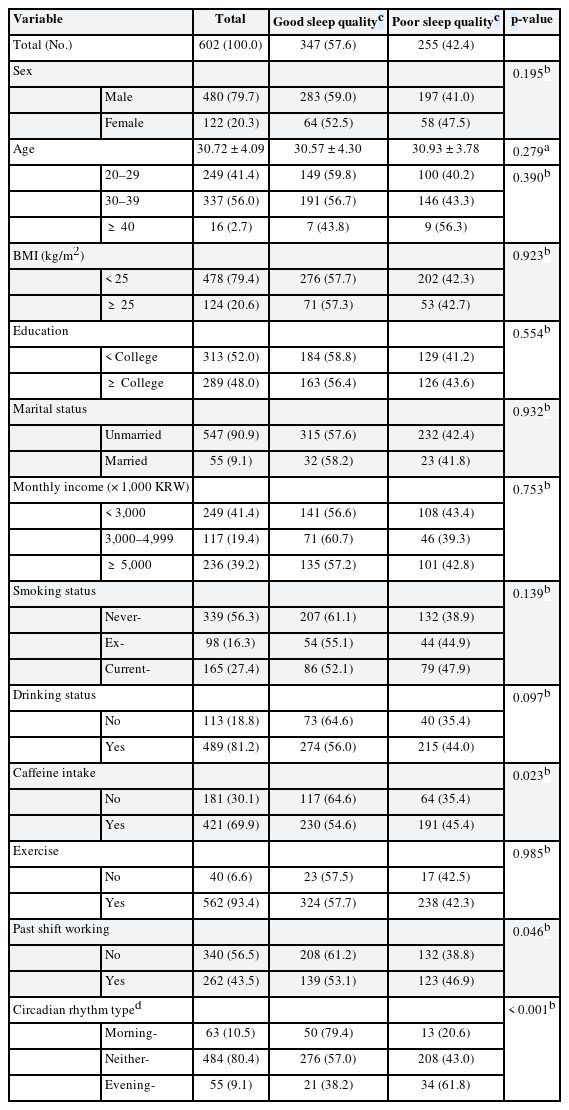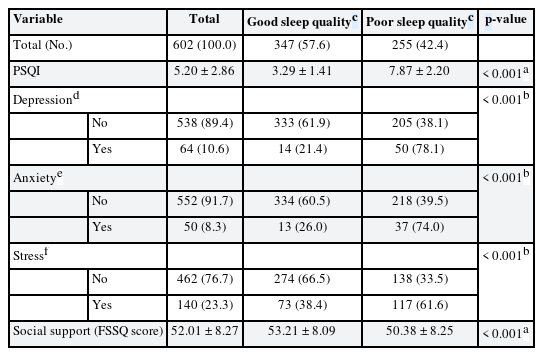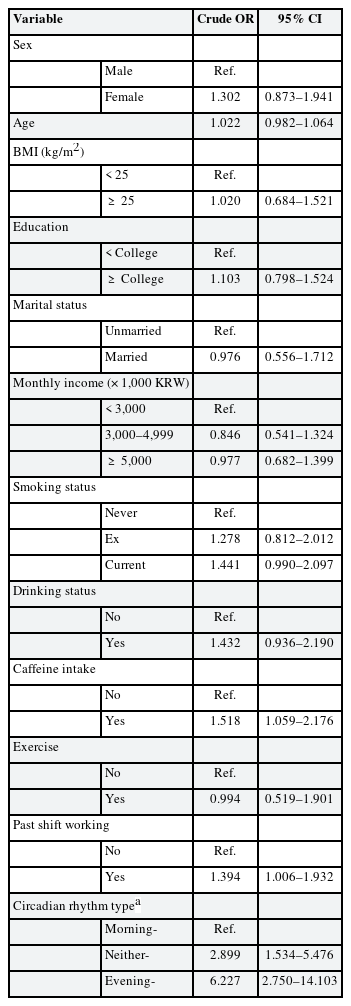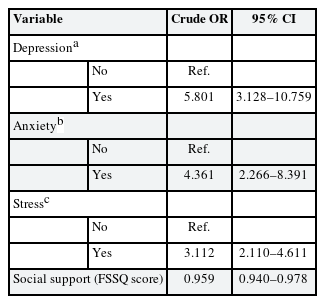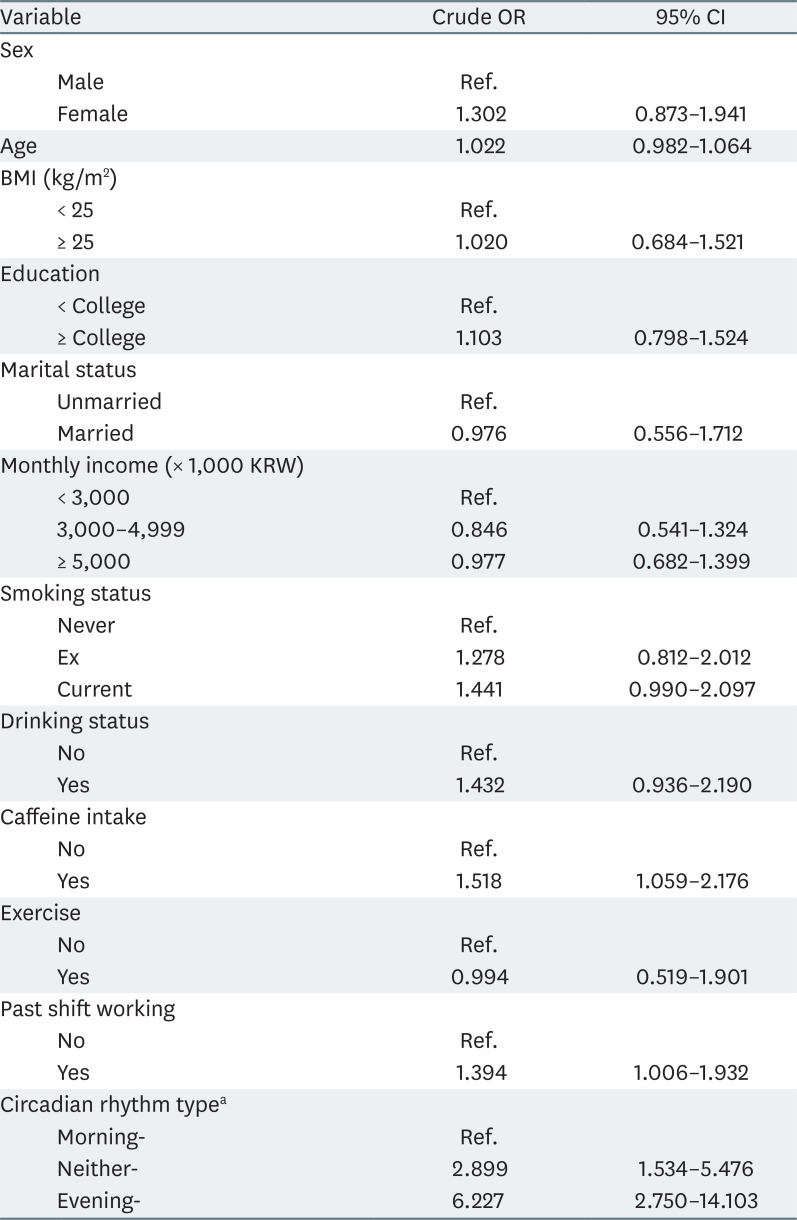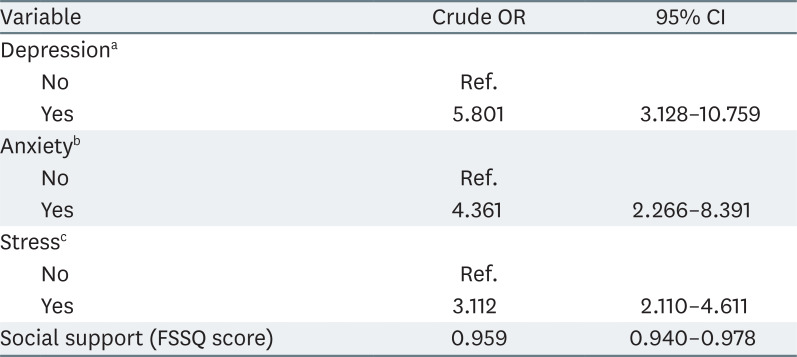Psychosocial factors affecting sleep quality of pre-employed firefighters: a cross-sectional study
Article information
Abstract
Background
There have been no health-related studies of pre-employed firefighters without firefighter-specific job-related factors (FSJRF). This study aimed to evaluate the sleep quality of pre-employed firefighters and to examine the relationship between sleep quality and psychosocial factors.
Methods
We conducted a self-report questionnaire survey for 602 pre-employed firefighters at 3 Fire Service Academies after brief lecture about sleep. Sleep quality and psychosocial variables such as depression, anxiety, stress and social support were evaluated. The independent 2 sample t-test, χ2 test and multiple logistic regression analysis were used to evaluate the effect of the variables on the sleep quality of pre-employed firefighters.
Results
Among a total of 602 people, 347 (57.6%) had good sleep quality and 255 (42.4%) had poor sleep quality. Pittsburgh Sleep Quality Index score of them was 3.29 ± 1.41) and 7.87 ± 2.20), respectively. 24 (4.0%) were evaluated to have insomnia by Insomnia Severity Index. Logistic regression analyses showed that the depression (adjusted odds ratio [aOR]: 5.940, 95% confidence interval [CI]: 3.124–11.292), anxiety (aOR: 4.233, 95% CI: 2.138–8.381), stress (aOR: 2.880, 95% CI: 1.915–4.330) and social support (aOR: 0.959, 95% CI: 0.939–0.980) have a significant effect on sleep quality after adjusted by sex, age, smoking status, drinking status, caffeine intake, past shift working and circadian rhythm type.
Conclusions
Depression, anxiety, stress and social support were associated with sleep quality among pre-employed firefighters. Repeated follow-up studies of pre-employed firefighters are needed to further assess their change of sleep quality and identify the FSJRF that may affect the sleep quality of firefighters.
BACKGROUND
Firefighters are who protect the lives and property of the people by preventing or suppressing fires, rescuing people and providing first-aid activities. Firefighters often suffer from lack of sleep because of the nature of their work requiring a 24-hour standby [1]. A previous study of firefighters showed that the prevalence of sleep disorders was 9.1% evaluated by Insomnia Severity Index (ISI) questionnaire [2], and firefighter-specific job-related factors (FSJRF), such as overtime working, job difficulties, and sudden schedule changes were factors affecting insomnia [3]. In addition, because they are put into dangerous and urgent work, the level of depression, anxiety and stress is higher than other jobs. This poor mental health can collapse the circadian rhythm and can lead sleep disorder [4567].
Factors affecting the quality of sleep include sleep hygiene and sleeping environment and circadian rhythm. Also, psychiatric diseases such as mood disorders, anxiety disorders and stress-related disorders can be one of them [8]. In case of firefighters, the sleep quality of evening-type firefighters evaluated by Korean translation of the Composite Scale (KtCS) was poorer than that of morning-type firefighters, and a previous study showed that stress and social support also affect the sleep quality of firefighters [791011].
There have been several studies on the factors affecting the quality of sleep for firefighters [8910111213]. However, most of the research were on firefighters who are already in their jobs, and as far as we know, there were no health-related studies of pre-employed firefighters who did not have any FSJRF. Pre-employed firefighters who have passed the Fire Service Officer Test in South Korea must have 15 weeks training course for basic knowledge and skills in performing their duties as firefighters such as fire suppression, rescuing and first aid at Fire Service Academy. The study of sleep quality and its affecting factors at the time when they are not yet working on firefighting service will be a good basis for further follow-up study after they are put into.
On the other hand, considering that the study subjects are still in pre-employment status, an analysis of the sleep quality of the study subjects compared with the job successful candidates (job entrance test passers) or seeker is also necessary. However, there have been no studies on sleep quality of pre-employee, and only a few studies evaluated the sleep quality using systematic evaluation tools for those who are in unemployment state [1415]. The sleep problems of these job seekers have been investigated as serious [1617].
The purpose of this study is to analyze the sleep quality of pre-employed firefighters and to investigate the relationship between psychosocial factors such as depression, anxiety and stress and social support, and sleep quality.
METHODS
Subjects
The subjects of this study are pre-employed firefighters who had passed the Fire Service Officer Test and had been trained 15 weeks course at Fire Service Academy. We visited the 3 Fire Service Academies (Yongin-si, Geyonggi-do; Cheonan-si, Chungcheongnam-do;Gongju-si, Chungcheongnam-do) from 2017 to 2018, and conducted a self-report questionnaire. Prior to the survey, we gave brief lecture about sleep and received written consent to participate in the study. We surveyed 951 pre-employed firefighters, and the 602 of them were finally included in this study, excluding 349 who did not respond to any of the questions such as basic demographic and psychosocial variables.
Variables for analysis
The questionnaires included socio-demographic characteristics such as sex, age, body mass index (BMI), education, marital status, monthly income, smoking status, drinking status, caffeine intake, exercise, whether to have an experience of shift work and circadian rhythm type. BMI was divided into 2 groups (<25 and ≥25 kg/m2), and education was categorized as “less than college graduate” and “college graduate and more educated”. Monthly income was divided into “less than 3 million Korean Won (KRW)”, “greater than or equal to 3 million KRW to less than 5 million KRW”, and “greater than or equal to 5 million KRW”. Smoking status, drinking status, caffeine intake, exercise and experience of past shift working were all divided into yes or no. The KtCS [1819] was used for evaluating circadian rhythm types. Although the cutoff point was not confirmed, a previous study suggested greater than or equal to 43 points as morning-type, less than 27 points as evening-type and others as neither-type [19]. In this study, the circadian rhythm type was classified into morning-type, evening-type and neither-type as the previous study suggested.
Psychological factors included depression, anxiety and stress. Patient Health Questionnaire-9 (PHQ-9) [20] was used for assessing depression, as normal with 4 or less, mild with 5 to 9, moderate with 10 to 14, moderate-to-severe with 15 to 19 and severe with greater than or equal to 20 points. Generalized Anxiety Disorder-7 (GAD-7) [21] was used as a tool for evaluating anxiety symptoms, 4 or less as normal, 5 to 9 as mild, 10 to 14 as moderate and greater than or equal to 15 as severe anxiety. Depression and anxiety symptom were divided into absent and present (sum of score < 5 or ≥ 5). The Perceived Stress Scale (PSS) [22] was used to assess stress. Since PSS is not developed for diagnostic purposes, no clear-cut point has been suggested, but a previous study suggested 17 as cut point [23].
As a tool to evaluate social support which means relationships with family, friends and colleagues, we used Functional Social Support Questionnaire (FSSQ) [24]. The higher the score, the higher the level of social support.
Sleep quality of pre-employed firefighters was assessed by Pittsburgh Sleep Quality Index (PSQI) [25]. The higher score means that the respondent has poor sleep quality. We assessed sleep quality by dividing into good and poor (PSQI sum of score < 6 or ≥ 6).
In addition to our main outcome, the quality of sleep according to PSQI score, Insomnia Severity Index (ISI) score and insomnia prevalence according to ISI score were briefly investigated to compare and discuss with the results of other studies on sleep characteristics. Presence of insomnia was evaluated as greater than or equal to 15 of ISI score.
Statistical analysis
Independent 2 sample t-test and χ2 test were performed to examine the relationship between the general characteristics, psychological factors, social support and sleep quality. And logistic regression analysis was conducted to evaluate the effects of psychosocial factors on sleep quality of pre-employed firefighters. Odds ratio (OR) and 95% confidence interval (CI) were calculated.
We used the PASW SPSS version 25 (SPSS Inc., Armonk, NY, USA) program for statistical analyses and set the significance level as below 0.05.
Ethics statement
All subjects in this study provided written informed consent. This study was approved by the Institutional Review Board of Yonsei University Wonju Severance Christian Hospital (CR318031).
RESULTS
Descriptive Statistics
General characteristics of this study are shown in Table 1 (socio-demographic variables) and Table 2 (psychosocial variables). Among a total of 602 people, 347 (57.6%) had good sleep quality (3.29 ± 1.41) and 255 (42.4%) had poor sleep quality (7.87 ± 2.20). 480 (79.7%) were men, 122 (20.3%) were women, and average of age was 30.72 ± 4.09. 124 (20.6%) were obese and 55 (9.1%) were married. At the time of the survey, current smokers were 165 (27.4%) and 489 (81.2%) responded drank alcohol. 421 (69.9%) responded that they consumed caffeine through coffee or green tea, and 562 (93.4%) responded that they exercised greater than or equal to the level of light walking. Two hundred sixty-two (43.5%) had experience of past shift working. The most common circadian rhythm type was neither-type (484, 80.4%), and the morning- and evening-type were 63 (10.5%) and 55 (9.1%), respectively. Sixty-four (10.6%) were evaluated as having depressive symptom, 50 (8.3%) as having anxiety symptom, and 140 (23.3%) as being under stress. The average FSSQ score for all the subjects was 52.01 ± 8.27.
Difference of sleep quality by psychosocial factors and others
There were significant differences in proportion of sleep quality according to caffeine intake (p = 0.023), past shift working (p = 0.046), circadian rhythm type (p < 0.001) and all psychological factors (depression; p < 0.001, anxiety; p = 0.001, stress; p < 0.001). The social support score was 53.21 ± 8.09 on average for group with good sleep quality and 50.38 ± 8.25 for group with poor sleep quality, and the difference was statistically significant (p < 0.001) (Tables 1 and 2).
Factors affecting the quality of sleep for pre-employed firefighters
The result of simple logistic regression for independent variables are shown in Table 3 (socio-demographic variables) and Table 4 (psychosocial variables). Factors affecting the sleep quality for pre-employed firefighters were caffeine intake (OR: 1.518, 95% CI: 1.059–2.176), past shift working (OR: 1.394, 95% CI: 1.006–1.932), circadian rhythm type (neither-type; OR: 2.899, 95% CI: 1.534–5.476, evening-type; OR: 6.227, 95% CI: 2.750–14.103), depression (OR: 5.801, 95% CI: 3.128–10.759), anxiety (OR: 4.361, 95% CI: 2.266–8.391), stress (OR: 3.112, 95% CI: 2.110–4.611) and social support (OR: 0.959, 95% CI: 0.940–0.978).
Multiple logistic regression analysis was conducted to evaluate the effects of psychosocial factors on the sleep quality of pre-employed firefighters (Table 5). After adjusting by sex, age, smoking status, drinking status, caffeine intake, past shift working and circadian rhythm type, adjusted OR is 5.940 for depression (95% CI: 3.124–11.292), 4.233 for anxiety (95% CI: 2.138–8.381) and 2.880 for stress (95% CI: 1.915–4.330). In addition, the higher the social support score, the better the quality of sleep (OR: 0.959, 95% CI: 0.939–0.980).
DISCUSSION
The purpose of this study was to evaluate the sleep quality of 602 pre-employed firefighters and the factors affecting sleep quality of them. Of them, 480 (79.7%) were male and 122 (20.3%) were female. Meanwhile, 347 (57.6%) were evaluated for good sleep quality, and 255 (42.4%) for poor sleep quality. The average PSQI score for the good sleep quality group was 3.29 ± 1.41, for the poor sleep quality group was 7.87 ± 2.20 and for the whole subject was 5.20 ± 2.862. The 97.3% of the subjects were in their 20–30s, 249 (41.4%) in their 20s and 337 (56.0%) in their 30s. In Yi’s study of some adults in Korea [26], the average PSQI score in early adult age under 40 was 5.7 ± 2.53, and in the study of Kim et al. [27], the average PSQI score for adult in their 30s was 5.21 ± 3.37, similar to our study result.
Considering that the subjects of this study is pre-employment status, it is necessary to compare the quality of the sleep of the subjects in this study with that of job-test passers. However, there have been no studies of job-test passers but of job seekers only. In Kim et al.'s study [27], the average PSQI score for adults in their 20s was 6.01 ± 2.76, which is higher than those for all subjects in this study (5.20 ± 2.86), and even higher than for subjects in their 20s in this study (4.98 ± 2.86). In addition to the sleep quality, the average Insomnia Severity Index (ISI) scores for all subjects and subjects in their 20s were 6.49 ± 4.34 and 6.52 ± 4.28 in this study, respectively(data not shown), whereas the previous studies found that the average ISI scores were 11.98 ± 5.03 for job seekers [28] and 10.07 ± 5.08 for adults in their 20–30s [29]. The subjects in this study were all firefighter nominees who had already passed Fire Service Officers Test, and 71.8% of them responded that they had a job other than firefighter in the past, of which 50.2% were qualified occupations such as nurses and emergency medical technicians. Given these factors, compared to job seekers, especially those in their 20s who are under a lot of unemployment stress, the subjects of this study are presumed to have a better sleep quality since they are somewhat out of the influence of unemployment stress, and therefore further studies are needed on this area.
In addition, Choi and Song [30] reported that the average PSQI score of 322 firefighters was 6.40 (±2.77), and 73.6% of them worked for more than six years. In addition, 42.0% of those in their 20–30s had poor sleep quality in our study, while 84.3% of those in their 20–30s had poor sleep quality in Choi et al.'s [13] study of male firefighters. In other words, the sleep quality of pre-employed firefighters was similar to that of the general adult population, and better than that of the firefighters who were actually engaged in the firefighting service. And for insomnia, the proportion of group evaluated as having insomnia by the ISI in this study was 3.2% in their 20s and 4.5% in their 30s (data not shown), compared with 7.1% in their 20s and 8.5% in their 30s in a previous study [2], respectively. The reason for this is maybe that the pre-employed firefighters have not yet been exposed to FSJRF. However, given that this study is aimed at pre-employed firefighters, unless there are specific interventions for other factors affecting their sleep quality, the proportion of groups with poor sleep quality or with insomnia symptom may be higher after being put into actual work. Therefore, repeated investigations of pre-employed firefighters and analyzation for the changes in sleep quality according to the working period will be required.
In previous studies, factors affecting sleep include BMI [3132], marital status [333435], smoking status [36], and drinking status [37]. In this study, there was no difference in sleep quality according to BMI and marital status. According to the 2017–2018 KNHANES (Korean National Health and Nutrition Examination Survey) data [3839], the obesity rate of adults in their 20s and 30s were 29.4%–26.9% and 33.4%–37.8%, respectively, whereas the that of the subjects in this study was only 20.6%. In other words, it was thought that there was no significant difference in the quality of sleep because the obesity rate of the subjects in this study was lower than that of adults in their 20–30s in Korea.
Also, according to previous studies [40], there was a strong association between close relationship such as marriage and sleep, and shift work was suggested as an important factor between them. However, in this study, it seems that the difference in quality of sleep according to the marital status was insignificant. The reason for this is maybe because the subjects were not yet employed in shift work. In addition, only 9.1% of those got married, which could be another reason.
Differences of the sleep quality between drinking status was borderline significant, which is thought to be because it was simply divided into yes or no at the time of the survey. Park et al. [37] reported that the Alcohol Use Disorder Identification Test-Korean revised version (AUDIT-KR) score was positively correlated PSQI score and significantly associated with subjective sleep quality, sleep duration and sleep disturbance for men. The results of ours could have been different if other criteria were taken regarding drinking.
In this study, the group which intake caffeine showed significantly higher proportion of poor sleep quality evaluated by PSQI. This trend was reported by Yoon et al.'s study of 119 paramedics [41] suggesting that the lower the number of caffeine drinks per day, the better the sleep quality, by Lee et al.'s study of college students [42] and by Watson et al.'s study of Australian adults [43], suggesting that the quality of sleep decreased as the amount of caffeine intake increased. However, since the intake of caffeine was analyzed by dividing only yes or no in this study, a clear association between caffeine intake and sleep quality could not be identified.
In addition, the study showed that the proportion of the group with poor sleep quality was significantly higher in the group with past shift working experience. A study of Jeong and Gu [44] reported that the longer the period of shift working, the lower the sleep quality, and several previous studies have suggested that the past shift working experience interfered with sleep [4546]. Marquié and Foret [45] reported that current and past shift workers reported more sleep problems than those who had never worked on shifts, and Dumont et al. [46] reported that former night-shift workers had high ISI scores, supporting our results.
There was also a significant difference in the quality of sleep between circadian rhythm types. This study found that the proportion of poor sleep quality group was significantly higher in the neither-circadian rhythm type than the morning-type, and in the evening-type than the neither-type. A study of the association between morning-night type and PSQI scores among university students reported that PSQI scores were higher in the evening-type group [47], and the other study of 50 healthy adults, using Actigraph (ActiGraph, LLC, Pensacola, FL, USA), reported that sleep quality was worse in the evening-type group than in the morning-/neither-type group [48], which supports the results of this study. However, since the effects of the circadian rhythm type on sleep seems to vary depending on the age, sex, comorbidity or characteristics of the study group, more sophisticated further study is required.
Psychological factors such as depression, anxiety and stress were evaluated through previously known assessment tools. In case of depression and anxiety, previous studies evaluated the presence of symptoms based on 10 points [82649]. However, we assessed the presence of the symptoms based on 5 points since the number of subjects who had depression and anxiety symptoms was too small when based on 10 points, with 16 and 14, respectively. For psychological factors such as depression, anxiety and stress, the group with psychological symptoms showed a significantly higher proportion of the poor sleep quality, compared to the group without psychological symptoms. This trend also coincides with previous studies showing poor sleep quality in groups with psychological symptoms such as depression [26], anxiety [49], and stress [50]. For depression and anxiety, unlike previous studies with moderate cut off points (≥ 10), this study showed significant differences in the proportion of sleep quality according to mild depression and anxiety symptoms. However, since this study is a simple cross-sectional study, longitudinal studies with mild symptom as cut off points are also necessary.
Social support scores also differed between groups. The results of this study showed that the higher quality of social support from family, friends and colleagues, the better the quality of sleep. There have been several studies on the relationship between social support and sleep, and in most studies, consistent results have been reported that the higher level of support was associated with better sleep or predicted better quality of sleep [51525354]. Especially after analyzing sleep pattern by Actigraph, the higher the perceived social support level, the better the objective sleep parameters [5254]. These results support the results of this study that the level of social support is significantly associated with quality of sleep. Meanwhile, several previous studies also suggested that there was a significant association between social strain and sleep, in addition to social support [5455]. Ailshire and Burgard [55] reported that the level of social strain, the worse the subjective sleep condition, and social strain was an only significant predictor for sleep quality, while social support had a buffering effect on the association between them, when both social support and social strain were considered in the model. However, since this study did not investigate the social strain, further studies including social strain are also required.
Logistic regression analysis was conducted to identify the effects of the psychosocial factors on the sleep quality of pre-employed firefighters. Consistent with previous studies [81011121326565758596061], psychosocial factors such as depression, anxiety, stress and social support were significant factors by logistic regression analysis. However, since there have been no previous studies of pre-employed populations, interpopulation comparisons for the effects of the psychosocial factors on sleep quality of pre-employed populations were impossible.
This study has several limitations. First, sleep quality, psychosocial factors and circadian rhythm types were all evaluated through subjective self-reporting questionnaire. Although the survey tools used in this study have been proven to be reliable and valid, the risks of non-response bias and recall bias cannot be ruled out. Second, 36.7% (n = 349) of the 951 who were initially recruited were excluded from the analysis. This is because only those who have fully responded to the survey questions in this study were included, and the risk of bias cannot be ruled out. Third, because the variables such as smoking status, drinking status, caffeine intake and experience of shift working, which are thought to have a significant effect on sleep quality, were classified simply as yes or no, the effects of these variables on sleep quality of pre-employed firefighters could not be evaluated in depth. Forth, the important factors that could affect the quality of sleep, such as presence or absence of children, child-care activities and the history of sleep medication were not included in this study. According to a previous study [62], it was suggested that child care activities was associated with the quality of sleep, but it was not included in the survey tool used in this study, so it was impossible to find out the influences of the such factor on the quality of sleep. However, there was not significant difference in sleep quality between unmarried and married people. In addition, the history of sleep medication is also an important factor affecting the quality of sleep, but in this study, the number of people who answered that they were currently taking sleeping pills was very small with 6, 1% of the total subjects. And the quality of sleep is expected to be poor for those who takes sleeping pills, so this study did not include the factor in the analysis. Fifth, since this study selected the subjects for a certain period and local area (subjects were recruited from only 3 Fire Service Academies of total 8 Fire Service Academies during 2017–2018), there was a limitation in generalizing the results of this study to all pre-employed firefighters. Sixth, because of the study design, cross-sectional study, we could not clearly identify the causal relationship between psychosocial factors and the quality of sleep. Also, since this study targeted as pre-employed firefighters who have not yet actually engaged in firefighting service, it was impossible to identify the effects of FSJRF. However, since we plan to follow up on the subjects in this study for at least 5 years, and if so, it will be possible to identify the effects of FSJRF on sleep quality and the causal relationship among firefighters.
Despite the above limitations, the advantages of this study are as follow: First, to our knowledge, this study is the first study about a pre-employed group of not only firefighters but also other occupations. Interventions for FSJRF could be expected if further investigations are conducted on these subjects and find out which FSJRF affects sleep quality of firefighters. As noted above, more significant results are expected if the subjects were followed based on the results of this study. Second, this study included as many psychosocial factors as possible that could affect sleep quality, including depression, anxiety, stress and social support. Therefore, the results of this study could be useful for future studies on psychosocial factors that may affect sleep quality.
CONCLUSIONS
The purpose of this study was to evaluate the quality of sleep and to identify factors that could affect sleep quality of the pre-employed firefighters. The average PSQI score was 5.20, which was similar to that of general population, and the quality of sleep was better than that of firefighters who are currently engaging in the firefighting service. 42.4% of the subjects reported poor sleep quality. Depression, anxiety, stress and social support were found to have a significant effect on sleep quality of pre-employed firefighters. Repeated follow-up studies of pre-employed firefighters are needed to further assess their sleep quality and affecting factors and to identify the FSJRF that may affect the sleep quality of firefighters. Through these studies, the effect of FSJRF to the quality of sleep would be evaluated and the quality of sleep would be improved by interventions on FSJRF in firefighters.
Notes
Funding: This research was supported by the Field-oriented Support of Fire Fighting Technology Research and Development Program funded by National Fire Agency (2017-NFA001-010-01010000-2020).
Competing interests: The authors declare that they have no competing interests.
Availability of data and materials: The datasets used and/or analyzed in this study are not publicly available from the corresponding author on reasonable request.
Author Contributions:
Conceptualization: Lim M.
Data curation: Lee S, Seo K, Oh HJ, Shin JS.
Formal analysis: Lim M.
Supervision: Lee S, Kim SK, Kang HT, Oh SS, Jeong KS, Koh SB, Ahn YS.
Writing - original draft: Lim M.
Writing - review & editing: Ahn YS.
Abbreviations
AUDIT-KR
Alcohol Use Disorder Identification Test-Korean revised version
BMI
body mass index
CI
confidence interval
FSJRF
firefighter-specific job-related factors
FSSQ
Functional Social Support Questionnaire
GAD-7
Generalized Anxiety Disorder-7
ISI
Insomnia Severity Index
KtCS
Korean translation of the Composite Scale
KRW
Korean Won
OR
odds ratio
PHQ-9
Patient Health Questionnaire-9
PSQI
Pittsburgh Sleep Quality Index
PSS
Perceived Stress Scale

